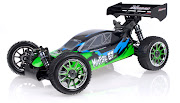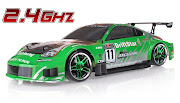In recent years, hobby-grade "ready-to-run" (or "RTR") models have become available from every major manufacturer of radio-controlled cars, attracting many hobbyists who would otherwise have purchased a pre-assembled car (ARTR or Race-Roller). Vehicles of this type need little or no final assembly and in most cases, the bodies are shipped painted and trimmed, requiring little or no work from the owner before they can be used (other than purchasing and installing batteries). A number of cars and trucks are presently available only in ready-to-run form. The growing popularity of the RTR vehicle has prompted many manufacturers to discontinue production of kit vehicles. High-spec racing vehicles are generally still available or sold only as kits, and companies like HPI and Tamiya sell kit and RTR versions with the benefits of a kit version being in upgraded parts or lower costs, respectively.
Electric models

Electrically powered models utilize mechanical or electronic speed control units to adjust the amount of power delivered to the electric motor. The power delivered is proportional to the amount of throttle called for by the transmitter - the more you pull the trigger, the faster it goes. The voltage is "pulsed" using transistors to produce varying output with smooth transitions and greater efficiency. Electronic speed controllers use solid state components to regulate duty cycle, adjusting the power delivered to the electrical motor. In addition, most electronic speed controllers can use the electric motor as a magnetic brake, offering better control of the model than is possible with a mechanical speed control. Mechanical speed controllers use a network of resistors and switch between them by rotating a head with an electrode around a plate that has electrical contacts. Mechanical speed controllers are prone to being slow to react because they are actuated by servos, waste energy in the form of heat from the resistors, commonly become dirty and perform intermittently, and lack a dedicated braking ability. They are less expensive than high performance electronic speed controls and usually ship in older hobby-grade models. They are gradually being phased out. Most electric cars up to recently used brushed motors but now many people are turning to brushless motors for their much higher power and because they require much less maintenance. They are rated either in relative turns or Kv. The Kv number tells how many RPM the motor will turn per volt, assuming no load and maximum efficiency. However, the ability of the system to put out power is dependent on the quality of the batteries used, wires and connectors supplying power. A well wired brushed system can outperform a poorly wired brushless system in many cases. Due to their power, brushless motors are also used in bigger monster trucks and 1/8 nitro-powered buggies that have been converted to electric. Some 1/5 scale gas to electric conversions are in production but are uncommon due to high price.
Nitro powered models
Nitromethane fuel powered models utilize a single servo for throttle and braking control; rotation of the servo in one direction will cause thethrottle on the carburetor to open, providing more air and fuel mixture to the internal combustion engine. Rotation of the servo in the other direction causes torque to be applied to a linkage and cam which causes friction with the braking material. The brake is commonly located on the driveshaft or spur gear in some cases and applies stopping power only to the driven wheels. Some models will also use an additional servo to control a transmission box, enabling the vehicle to drive in reverse.
Fuel engine sizes most often range between .12-.35 cubic inches. This is due to restrictions by the main sanctioning bodies for radio-controlled racing. Many "outlaw" engines are manufactured larger than these, mainly intended for vehicles which will not be used in sanctioned races and therefore do not need to comply with these regulations. Engine size is related to the class of car; 1/10th scale on and off road vehicles usually are equipped with .12-.18 cubic inch engines, with 1/8th scale vehicles using .21-.32 cubic inch engines. There are exceptions, with many Schumacher and Thunder Tiger/Team Associated RC models being good examples of unusually large engines coming as standard equipment on certain models.
An Ofna Hyper 8 Pro 1:8-scale nitro-powered racing buggy.
Fuel-powered engines allow model cars to reach moderate speeds unmodified. Maximum power is generally achieved at medium to high speeds, and a slightly slower throttle response than electrically powered vehicles is to be expected due to clutching and lack of torque. Electric motors effectively produce instantaneous torque, whereas nitro engines, like full-sized gasoline engines, take time for the engine to spool up and for the clutch to engage. Nitro- (and fuel) powered cars may be refueled and returned to action in a few seconds, as opposed to electrics needing to remove the body shell and battery fasteners to replace a discharged battery. Nitro cars are cooled some by air, some by the oil mixed in with the fuel and may be run continuously with no need to take breaks for cooling down assuming they are properly tuned.
Nitro-powered cars operate like full-sized fuel vehicles more than their electric counterparts do, making use of a two stroke engine rather than an electric motor. The sound of the engine and generally higher stock top speeds are main selling points to nitro enthusiasts. However, their exhaust contains unburned oil, which usually ends up coating the chassis. This, in turn, requires more cleaning than an electric-powered equivalent. Cleaning is usually achieved by the use of compressed air nozzles and solvents (such as denatured alcohol). Tuning a fuel-powered vehicle requires learning to maintain optimum performance and fuel economy, and to minimize engine wear and overheating, even in ready-to-run vehicles. Running a nitro-fuel motor without tuning or tuning improperly can hurt performance in rich conditions, and cause severe damage in lean conditions.
Because of higher stock performance and their ability to be driven for longer periods of time, mechanical wear in nitro vehicles is generally greater than in electric vehicles. In addition, the increased speed and weight of fuel-powered vehicles generally lead to higher speed collisions, causing greater damage to the collided vehicles, and a greater degree of safety concerns needs to be taken into account. Maintenance such as cleaning of the air filter and general chassis cleaning, replacement of worn clutch parts, proper after-run lubrication (necessary for storage) and maintenance of other motor-related items such as glow plug replacement makes for a more frustrating experience for first time RC users. In addition, nitro motors typically require rebuilding or replacement after 2-8 gallons of fuel run through them, due to loss of compression, which can be accelerated by poor tuning and overheating. It is also possible to seriously damage the engines by over-revving them with no load or ingestion of dirt into the carburetor. As such, nitro-powered vehicles are by nature expensive to maintain.
Gasoline powered models
Gasoline powered vehicles, also known as "fuelies" or "gassers", run on a mix of gasoline and oil. They cost much more (usually $800–$3000 RTR) than nitro and electric cars. They are also much bigger and therefore require much more space to run. They do not usually have as high top end speeds (compared to nitro and some electrics) but have lots of power and do not take a lot of fuel to run. Over time the cost of a gas-powered car can be less than some nitro-powered vehicles, because of the high cost of nitro fuel and buying new nitro engines to replace worn-out ones. In addition, gas-powered motors rarely if ever require tuning and have a very long lifespan. These large scale models have been popular in Europe for over a decade and have recently become very popular in the US thanks to companies like HPI Racing producing affordable high quality models locally.
 Take your radio control experience off-road with the all new Rock Crawler from Maisto. This off-road radio control truck boasts articulated suspensions, two motors and low gearing to make for awesome rugged off-road action. Rock Crawler is 12.5'' long and sports both front and rear suspension. Tri-channel transmitter allows for three people to play simultaneously with their other Maisto radio control vehicles. Go off-road with your brand new Rock Crawler today.
Take your radio control experience off-road with the all new Rock Crawler from Maisto. This off-road radio control truck boasts articulated suspensions, two motors and low gearing to make for awesome rugged off-road action. Rock Crawler is 12.5'' long and sports both front and rear suspension. Tri-channel transmitter allows for three people to play simultaneously with their other Maisto radio control vehicles. Go off-road with your brand new Rock Crawler today.
















